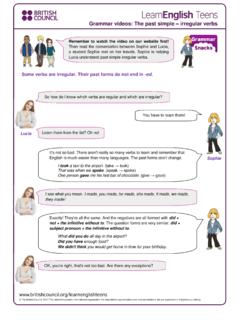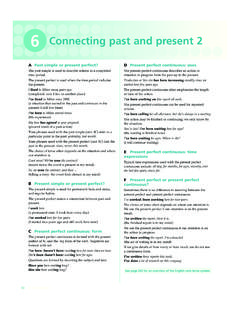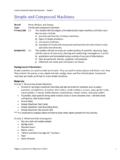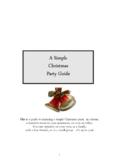Transcription of National Literacy and Numeracy Learning Progressions
1 COPYRIGHT The National Literacy Learning Progressions are licensed under a creative commons Attribution-NonCommercial International (CC BY-NC ) licence. See ( ). You are free to share (copy and redistribute the material in any medium or format) and adapt (remix, transform, and build upon) these materials for non-commercial purposes only, provided you attribute ACARA. See attribution notice under our Copyright and terms of use ( ). For the avoidance of doubt, this means that you must not use these materials for commercial purposes. National Literacy and Numeracy Learning Progressions Literacy Progression Appendices 6 Text co mplexi ty COPYRIGHT The National Literacy Learning Progressions are licensed under a creative commons Attribution-NonCommercial International (CC BY-NC ) licence.
2 See ( ). For more information, please see the first page of these materials and our Copyright and terms of use ( ). 2 Appendix 6. Text complexity Text complexity advice describes the features and scope of texts students work with in the Australian Curriculum leaning areas F 10. Throughout their school years, students will be exposed to texts with a range of complexity. There are four levels of text complexity: simple , predictable, moderately complex and sophisticated. Text complexity classifications are referenced throughout the progression. The Australian Curriculum defines text as: a means for communication. Their forms and conventions have developed to help us communicate effectively with a variety of audiences for a range of purposes. Texts can be written, spoken or multimodal and in print or digital/online forms.
3 Multimodal texts combine language with other systems for communication, such as print text, visual images, soundtrack and spoken word as in film or computer presentation media. In the final online version of the Learning progression, this advice will be interactive. simple texts (including *decodable texts) simple texts are the simplest form of continuous texts. simple text include sentences which are linked to form a cohesive text. Vocabulary names of familiar people, places and things common adjectives (red, big, happy) mainly generic words (cut rather than slice) words used reflect the most common and literal meaning of the words (sound meaning noise , not satisfactory) a few interesting words that may be new, but are easy to understand and well supported within the text high-frequency words words that can be used as language play (rhyming words, nonsense words) Language mainly simple , predictable sentences some compound sentences mainly shorter sentences.
4 3 10 words in length simple past tense or simple present tense simple adverbial phrases of place, time (in the playground, before lunch) a few simple contractions and possessives sentences that are questions simple punctuation marks (full stop, exclamation mark, comma) simple rhythm to language COPYRIGHT The National Literacy Learning Progressions are licensed under a creative commons Attribution-NonCommercial International (CC BY-NC ) licence. See ( ). For more information, please see the first page of these materials and our Copyright and terms of use ( ). 3 Structure repeated or cumulative patterns simple chronological patterns images support meaning structure is familiar and consistent with typical structure for the type of text (imaginative texts with orientation, complication and resolution) simple cause-and-effect relationships clear signals and transitions to lead the reader through a story, process or set of concepts Content ideas close to children s experience content presented from a single perspective purpose or main idea is explicit and clear from early in the text one or two literal ideas explored simple plot realistic characters, settings and events imaginary characters, events (some containing humour) simply stated facts or information (The library is closed.)
5 Print and layout features read in one sitting font mostly large and clear occasional bolding of text some print in speech or thought bubbles digital texts navigable by icons with concise words to describe (print and colour, food, animals) illustrations/images engaging, simple and provide visual support some labels title, author, illustrator listed on front cover and title page Predictable texts (including *decodable texts) Vocabulary Learning area specific vocabulary large core of high-frequency words new or less familiar words scaffolded or supported through context synonyms for frequently occurring vocabulary descriptive language including made-up words and words that are represented playfully Language a range of cohesive devices including pronouns, determiners and temporal connectives COPYRIGHT The National Literacy Learning Progressions are licensed under a creative commons Attribution-NonCommercial International (CC BY-NC ) licence.
6 See ( ). For more information, please see the first page of these materials and our Copyright and terms of use ( ). 4 a range of sentences including complex sentences with dependent clauses simple dialogue with the speaker clearly assigned some poetic language (onomatopoeia, alliteration rhyme,) adverbs and prepositional phrases for circumstantial details Structure mainly follows a predictable structure (a persuasive text that opens with a statement of position) explicit signposting using organisational markers such as paragraphs some less predictable elements little demand on a reader to reference forward or backward to comprehend the text clearly signalled deviations from predictable structures explicit and clear connections between parts of the text clear text purpose clear, logical constructs (cause-and-effect relationships or chronological relationships)
7 Images that enhance the meaning of the text Content ideas or information clearly explained and described levels of meaning some implicit or inferred meaning some implicit or subtle connections between events or ideas prior or cultural knowledge may be required to understand content (some understanding of insects to read texts on butterflies) obvious intertextual references (fairytales) low levels of abstraction simple elements of fantasy (anthropomorphic characters) Print and layout features words with varying font sizes, colour and shape, bolding and italics author dedication end papers simple table of contents digital texts navigable by a combination of text and icons digital texts that contain multiple pathways to navigate the same page some use of sidebar navigation images in a variety of forms, labels, captions, maps, photographs, animations special features that make the text interactive (flaps, buttons, sound) Moderately complex texts Vocabulary a range of synonyms and antonyms with subtle shades of meaning technical and discipline-specific words and phrases COPYRIGHT The National Literacy Learning Progressions are licensed under a creative commons Attribution-NonCommercial International (CC BY-NC )
8 Licence. See ( ). For more information, please see the first page of these materials and our Copyright and terms of use ( ). 5 words with multiple connotations /meanings figurative language (similes and metaphors) idiomatic language ( on thin ice ) words that are used ironically to create humour occasional words from languages other than English words that can be understood using root words and knowledge of prefixes and suffixes (unsure, sleepily) Language complex sentences with several subordinate phrases or clauses extended noun groups (forces of attraction and repulsion) rhetorical devices (metaphor and hyperbole) nominalisation tense varied within the text complex punctuation longer passages of detailed description modal language used to express degree of possibility, probability, obligation and permission conditional/concessional cohesive devices (although, instead, compared to) literary devices (sarcasm, irony) active and passive voice lexical cohesion across text (herbivore, nocturnal, tree-dwelling) Structure organisational markers such as subheadings, chapter headings, sidebars and breadcrumbs connections between an expanded range of ideas, processes or events are deeper and often implicit or subtle text structure related to specific disciplines (explanations and evaluative responses)
9 Unique structure (narrative may include concurrent storylines and shifts in time) multiple reading paths images supplement and extend meaning of text intertextuality through adaptation of structure and style Content extensive descriptive detail multiple perspectives represented abstract concepts topics or ideas presented with significant details or elaboration main idea or message may need to be inferred inferred or implicit meanings throughout text (intertextual references) discipline-specific content (competition among species) complex characters multiple characters images supplement and extend meaning of text COPYRIGHT The National Literacy Learning Progressions are licensed under a creative commons Attribution-NonCommercial International (CC BY-NC ) licence.
10 See ( ). For more information, please see the first page of these materials and our Copyright and terms of use ( ). 6 Print and layout features texts of variable length (chapter books, long illustrated texts, picture books) digital texts containing multiple pages and links with multimodal content texts in a wide variety of forms (web pages, podcasts) sidebar and breadcrumb navigation acknowledgements, authors notes, index Sophisticated texts Vocabulary words that appear in academic disciplines extensive technical and Learning area specific vocabulary (increment) substantial use of figurative language, including in non-fiction texts subtle evaluative language reflecting author viewpoint vocabulary that requires use of tools such as glossaries less common affixes (mismanagement)






